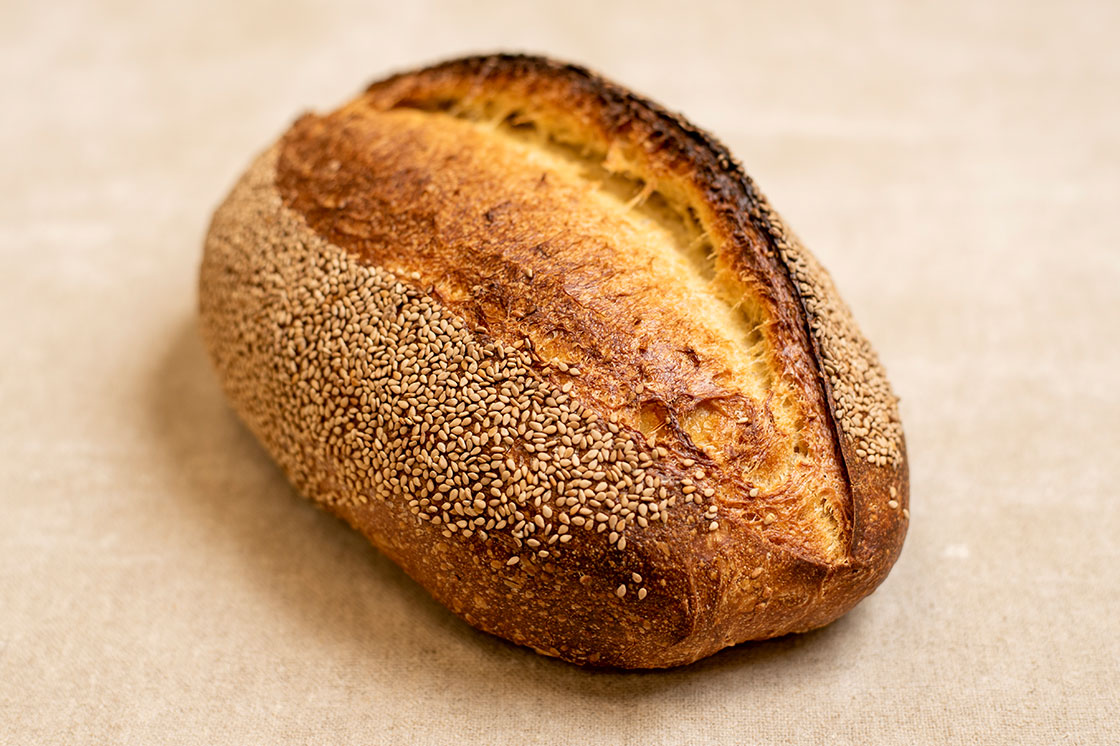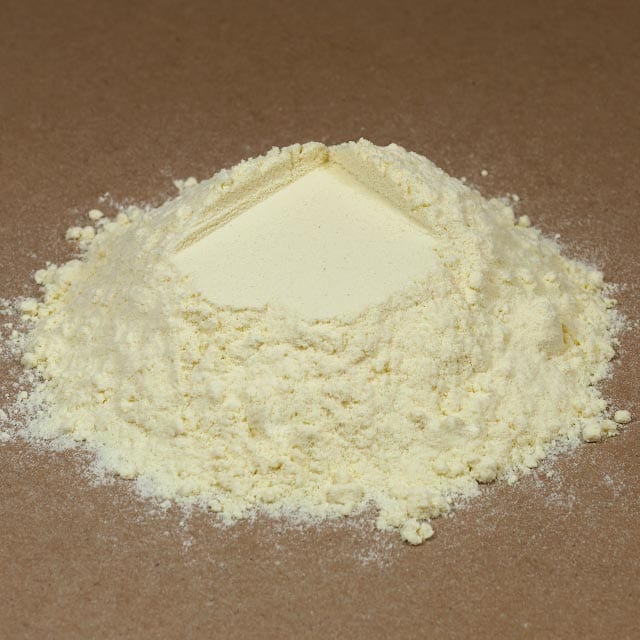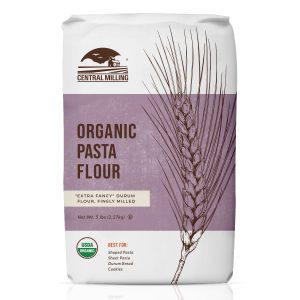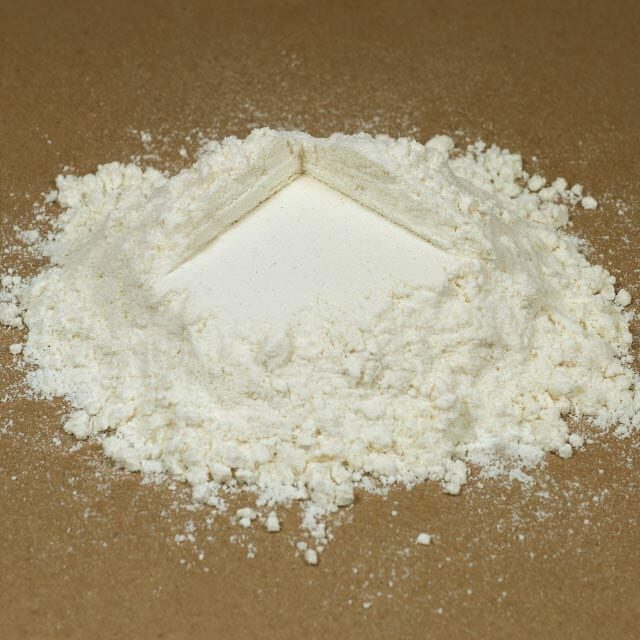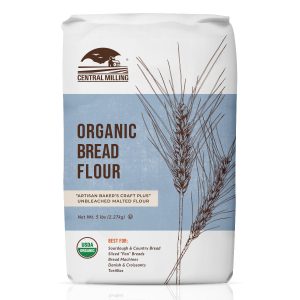This gorgeous loaf of sourdough features amazing color and texture thanks to the Organic Pasta Flour flour used. Comprised of Durum Wheat milled to a super fine (or “Extra Fancy” as us millers call it) granulation, the flour creates a soft and silky sourdough with a distinct yellow(ish) color. The recipe also features toasted sesame seeds – both inside and out – which adds an unmistakeable aroma and flavor to the loaf. Slices of this bread are perfect for sandwiches, breakfast toast, dipped in tomato soup, stews, and more.
On a practical note, this durum sesame bread is formulated to be mixed and baked on the same day which is perfect for bakers who want to make sourdough, but don’t have the space for proofing in their refrigerator.
Formula
Number of Units: 2 loaves / Unit Weight: 750 grams / Total Weight: 1500 grams
| PREFERMENT | Baker’s % | Weight |
|---|---|---|
| Bread Flour | 100 | 245 g |
| Water | 100 | 245 g |
| Active Sourdough Starter | 20 | 49 g |
| Total | 220 | 539 g |
| FINAL DOUGH | Baker’s % | Weight |
|---|---|---|
| Organic “Extra Fancy Durum” Pasta Flour | 85 | 485 g |
| Bread Flour | 15 | 86 g |
| Salt | 2 | 17 g |
| Water | 60 | 343 g |
| Sesame Seeds, Toasted | 5 | 30 g |
| Preferment | 94 | 539 g |
| Total | 261 | 1500 g |
| TECHNICAL | |||
|---|---|---|---|
| Preferment Time and Temp | 12–16hr @ 75˚ F | ||
| Dough temperature | 75–78˚ F | ||
| Mixing Type | Mixer | ||
| First Speed | 3 min | ||
| Second Speed | 7 min | ||
| Gluten structure | Improved | ||
| First fermentation | 2 hr @ RT | ||
| Folds | 4 | ||
| Fold Time | 30 min | ||
| Dividing | 750 g or two equal portions | ||
| Pre-shaping | round | ||
| Resting time | 20 min | ||
| Shaping | Batard or round | ||
| Final Fermentation | 2 hr @ RT | ||
| Baking* | 35-45 min @ 460˚ F | ||
| Steam | Yes | ||
*Baking time and temp can vary depending on oven.
Timing
Active Time: 30 min / Inactive time: 17–21 hrs / Baking Time: 35–45 min
Process
The Evening Before
In a medium bowl, mix all the Preferment ingredients together until they are thoroughly combined and there is no visible dry flour in the bowl.
Cover the bowl in plastic wrap and let it sit in a warm place for 12–16 hours.
The Day of Baking
Using a stand mixer, or by hand, mix the preferment, flours, salt, and 90% of the water together. Add half of the remaining water into the mixture to pick up and hydrate the leftover dry flour in the bowl.
Once the dough doesn’t have any more visible dry flour, go ahead and knead the dough until it starts developing a smoother surface, pulls clean from the sides of the bowl, and has the ability to create a windowpane with a slightly jagged tear. This can take anywhere from 5–10 minutes.
Add the toasted sesame seeds and the remaining water into the dough and mix until the water has all been absorbed and the seeds are evenly distributed.
Cover the bowl and let the dough rest for the first fermentation of 2 hours. During this time, you want to develop the gluten with a series of “stretch and folds” every 30 minutes:
Let the dough fall from the bowl onto the table, scraping out the remaining dough if needed.
Take the top part of the dough, stretch it away from yourself and then fold it back on to the dough (towards yourself) about 1/3 of the way. Now, take the bottom of the dough and do the opposite: stretch it towards yourself and then fold it back over the first fold to the end of the dough.
Do the same to the left and right side.
Next, take the top of the dough mass and fold it over the center, in thirds, and continue the motion until it has rolled over with the seam-side down and smooth side up.
Slide both hands underneath the halfway point of the dough, vertically. Lift it up and place it back in the bowl allowing the ends to tuck themselves under, leaving a smooth surface on top.
Cover the bowl and let the dough rest for 30 min and repeat the folding technique until the total first fermentation time has passed. With each fold, you should be able to start feeling the dough gaining strength, and start seeing the surface of the dough becoming smoother.
After 2 hours, turn the dough out onto a lightly floured surface, divide it into two equal portions and lightly pre-shape into balls. Take care to not use too much flour as you are pre-shaping. You don’t want the dough to be too sticky, but don’t want to have a lot of raw flour inside the dough either. Let this rest for 20 min on the table. If there is a draft, cover the dough with a towel to prevent the surface from drying out.
During this time, prepare a bread form, banneton, or couche by either dusting the inside with flour or placing a linen cloth inside the form and dusting the cloth.
After the dough has rested for 20 min, shape the dough into a batard (or boule if you prefer), dampen the surface of the dough and sprinkle or roll the dough in sesame seeds and place the dough into the form with the seam side facing up. Cover the dough and let proof for 2 hours in a warm, draft-free place.
Time to Bake!
Preheat your oven to 475˚ F for 1–2 hours prior to baking. Make sure to give your baking stone, steel or dutch oven plenty of time to preheat as well.
If you are baking on a steel or stone, turn the dough gently onto a lightly dusted peel or parchment, score the top and slide it onto the steel/stone. Quickly add steam into the oven, close the oven door, and bake for 35–45 min
If using a dutch oven, turn the dough gently onto a piece of parchment, score the top and lower it gently into the dutch oven. Place the lid on the dutch oven and bake for 25 minutes. After 25 minutes, remove the lid, lower the temperature to 425˚ F and continue baking for another 10–15 minutes until the crust develops a dark golden color. The bottom of the bread should not be burnt, but when knocking on it, should sound like a hollow thud.
Take the bread out of the oven and place it onto a cooling rack and try to let it cool completely (at least 30 minutes, ideally 60) before cutting into it. Enjoy!




